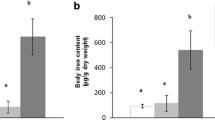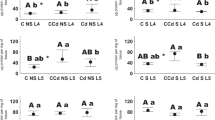Abstract
The effect of mercury as Hg2Cl2 and HgCl2 on the antioxidant enzyme levels and its toxicity was investigated in an insect model comprised of adult females of the common housefly, Musca domestica, and fourth-instar larvae of the cabbage looper moth, Trichoplusia ni. HgCl2 was found to be more toxic than Hg2Cl2 to both M. domestica and T. ni. The LC50s for M. domestica were 1.17% and 0.38% w/v concentration for Hg2Cl2 and HgCl2, respectively. For the more tolerant T. ni, the LC50s were 5.15% for Hg2Cl2 and 0.96% w/w concentration for HgCl2. The minimally acute LC5 dose of both oxidation states of Hg was approximately 0.005% for both insects (w/v for M. domestica and w/w for T. ni). At the LC5, both forms of Hg significantly induced the activity of superoxide dismutase in both insect species. Catalase was induced by both Hg2Cl2 and HgCl2 in M. domestica but was only induced by HgCl2 in T. ni. Glutathione-S-transferase, its peroxidase activity, and glutathione reductase activites were also significantly altered in most cases by Hg in both insects although the pattern of alteration was different between the two insects. It is evident that mercury induces oxidative stress in insects as it does in vertebrates. Our findings suggest that insects may serve as a valuable, non-mammalian model species to assess Hg-induced oxidative stress as a component of environmental toxicity.
Similar content being viewed by others
References
Aebi H (1984) Catalase in vitro. Meth Enzymol 105:121–126
Ahmad S (1992) Biochemical defence of pro-oxidant plant allelochemicals by herbivorous insects. Biochem Syst Ecol 20:269–296
Ahmad S, Pardini RS (1988) Evidence for the presence of glutathione peroxidase activity toward an organic hydroperoxide in larvae of the cabbage looper moth, Trichoplusia ni. Insect Biochem 18:861–866
—, — (1989) Corrigendum. Insect Biochem 19:109
—, — (1990) Mechanisms for regulating of oxygen toxicity in phytophagous insects. Free Rad Biol Med 8:401–413
Ahmad S, Pritsos CA, Bowen SM, Heisler CR, Blomquist GJ, Pardini RS (1988) Antioxidant enzymes of larvae of the cabbage looper moth, Trichoplusia ni: Subcellular distribution and activities of superoxide dismutase, catalase, and glutathione reductase. Free Rad Res Commun 4:403–408
Ahmad S, Pritsos CA, Bowen SM, Kirkland KE, Blomquist GJ, Pardini RS (1987) Activities of the enzymes that detoxify superoxide anion and related oxyradicals in Trichoplusia ni. Arch Insect Biochem Physiol 7:85–96
Ahmad S, Pritsos CA, Pardini RS (1990) Antioxidant enzyme activities in subcellular fractions of larvae of the black swallowtail butterfly, Papilio polyexenes. Arch Insect Biochem Physiol 15:101–109
Anonymous (1986) Test methods for evaluating solid waste. Vol IA: Laboratory Manual Physical/Chemical Methods, SW-846, 3rd ed, U.S. Environmental Protection Agency, Washington, DC
Chung A-S, Maines MD, Reynolds WA (1982) Inhibition of the enzymes of glutathione metabolism by mercuric chloride in the rat kidney: Reversal by selenium. Biochem Pharmacol 31:3093–3100
Corbett JR (1974) The biochemical mode of action of pesticides. Academic Press, London
Finney DJ (1964) Probit analysis. 2nd ed. Cambridge University Press, London
Friberg L, Nordberg G, Vouk VB (1979) Introduction. In: Friberg L, Nordberg G, Vouk VB (eds). Handbook on the toxicology of metals Elsevier/North-Holland, Amsterdam, pp 1–11
Fridovich I (1983) Superoxide radical: An endogenous toxicant. A Rev Pharmacol Toxicol 23:239–257
Grinstein S, Rothstein A (1978) Chemically-induced cation permeability in red cell membrane vesicles. Biochim Biophys Acta 508: 236–245
Gwozdzinski K, Roche H, Peres G (1992) The comparison of the effects of heavy metal ions on the antioxidant enzyme activities in human and fish Dicentrarchus labrax erythrocytes. Comp Biochem Physiol 102C:57–60
Habig WH, Jakoby WB (1981) Glutathione-S-transferase in rat and human. Meth Enzymol 77:218–231
Halliwell B, Richmond R, Wong SF, Gutteridge JMC (1980) The biological significance of the Haber-Weiss reaction. In Bannister WH, Bannister JV (eds.) Biological and clinical aspects of superoxide and superoxide dismutase Elsevier/North-Holland, Amsterdam, pp 32–41
Luckey TD, Venugopal B, Hutcheson D (1975) Environmental quality and safety. Supplement Vol 1. Academic Press, NY
Lund B-O, Miller DM, Wood JS (1991) Mercury-induced H2O2 production and lipid oxidation in vitro in rat kidney mitochondria. Biochem Pharmacol 42:181–187.
McCord JM, Fridovich I (1969) Superoxide dismutase. J Biol Chem 244:6049–6055
Miquel J (1989) Historical introduction to free radical and antioxidant biomedical research. In: Miquel J, Quintanilha AT, Weber H (eds), CRC handbook of free radicals and antioxidants in biomedicine, CRC Press, Boca Raton, FL, vol 1, pp 3–11
Oberley LW, Spitz DR (1984) Assay of superoxide dismutase activity in tumor tissue. Meth Enzymol 105:457–464
Passow H, Rothstein A, Clarkson TW (1961) The general pharmacology of the heavy metals. Pharmacol Rev 13:185–224
Pritsos CA, Ahmad S, Bowen SM, Blomquist GJ, Pardini RS (1988a) Antioxidant enzymes in the southern armyworm, Spodoptera eridania. Comp Biochem Physiol 90C:423–427
Pritsos CA, Ahmad S, Bowen SM, Elliott AJ, Blomquist GJ, Pardini RS (1988b) Antioxidant enzymes of the black swallowtail butterfly, Papilio polyxenes, and their response to the pro-oxidant allelochemical, quercetin. Arch Insect Biochem Physiol 8:101–112
Racker E (1955) Glutathione reductase (liver and yeast). Meth Enzymol 2:722–725
Ribarov SR, Benov LC (1981) Relationship between the hemolytic action of heavy metals and lipid peroxidation. Biochim Biophys Acta 640:721–726
Stacey NH, Kappus H (1982) Cellular toxicity and lipid peroxidation in response to mercury. Toxicol Appl Pharmacol 63:29–35
Stewart RM (1977) Laboratories section procedures for the characterization of water and wastes. County Sanitation Districts of Los Angeles County, 3rd ed, Whittier, CA
Venugopal B, Luckey TD (1978) Metal toxicity in mammals. Part 2: Chemical toxicity of metals and metalloids. Plenum Press, NY
Weinhold LC, Ahmad S, Pardini RS (1990) Insect glutathione-Stransferase: A predictor of allelochemical and oxidative stress. Comp Biochem Physiol 95B:355–363
Author information
Authors and Affiliations
Rights and permissions
About this article
Cite this article
Zaman, K., MacGill, R.S., Johnson, J.E. et al. An insect model for assessing mercury toxicity: Effect of mercury on antioxidant enzyme activities of the housefly (Musca domestica) and the cabbage looper moth (Trichoplusia ni). Arch. Environ. Contam. Toxicol. 26, 114–118 (1994). https://doi.org/10.1007/BF00212802
Received:
Revised:
Issue Date:
DOI: https://doi.org/10.1007/BF00212802




